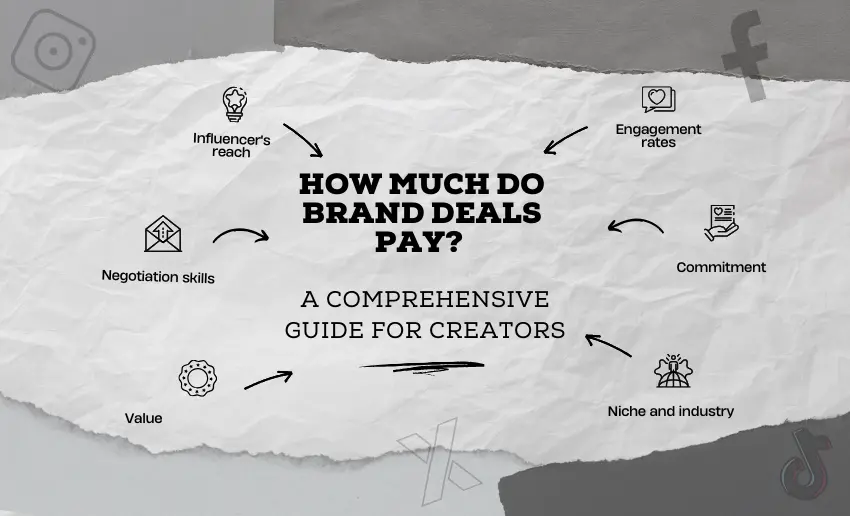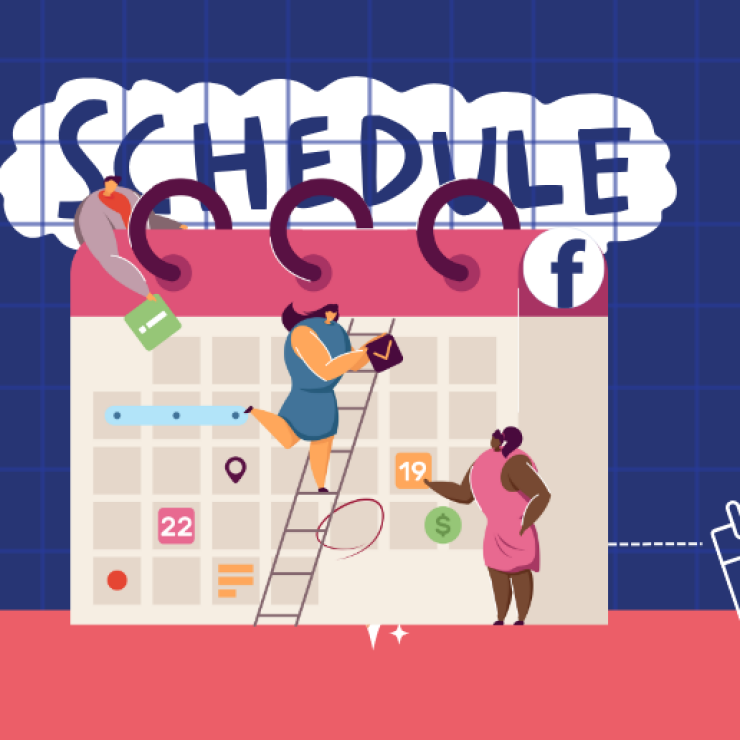Brand deals are agreements between individuals, typically social media influencers or content creators, and companies or brands. These agreements involve the influencer promoting the brand’s products, services, or image to their audience through their content.
Online content creators have always leveraged brand deals as a means to make money. These deals are like partnerships between influencers and companies, where the influencer promotes the company’s products or services to their audience. But one big question that comes to mind is, “How much do brand deals pay?” It’s a question that both aspiring and established influencers want answers to.
Thankfully, in this piece, you will understand the world of brand deals and uncover the factors that determine how much money influencers can make from these collaborations.
How much are brand deals worth?
Earnings from brand deals can vary significantly, with some making as little as $20 to $250 per deal, while others can earn a substantial $1,500 to $10,000. At other times, paid brand deals can pay as high as hundreds of thousands of dollars for a single deal.
Its clear from the above that when it comes to how much does a brand deal pay, the answer ranges within a wide spectrum. Regardless, several factors determine how much a brand deal can pay you. These factors include:
1. Influencer’s reach
An influencer’s “reach” refers to the total number of people who see their content. It’s like the size of their online audience. The larger the reach, the more brands are interested in working with them. An influencer with a significant reach can command higher payments because they have the potential to expose the brand to a broader audience. So, a big reach often means bigger brand deal payments.
However, it’s not just about quantity, but quality too. Having fake or inactive followers can hurt an influencer’s chances of securing higher payments, as brands are increasingly focusing on engagement over sheer numbers.
2. Engagement rates
Engagement measures how much the audience interacts with an influencer’s content. This includes likes, comments, and shares. High engagement rates indicate that the audience is genuinely interested in what the influencer shares. Influencers with high engagement often get paid more because they can deliver brand messages effectively and authentically to their engaged followers.
3. Niche and industry
An influencer’s niche, or the specific area they create content about, greatly affects their brand deal payments. Some niches, like beauty or fashion, are highly sought after by brands, leading to better payment opportunities. The industry also plays a role. For example, technology companies might pay more to tech influencers than to influencers in other niches.
4. Content quality and consistency
Brands value influencers who produce high-quality content consistently. High-quality content reflects well on the brand and can persuade more people to engage with it. Influencers who maintain a consistent posting schedule and deliver content that aligns with brand values can often command higher payments.
5. Negotiation skills
Negotiation is a crucial factor in brand deal payments. Influencers with strong negotiation skills can secure more favorable terms, whether that’s higher pay, additional perks, or creative control. Effective negotiation can lead to better compensation for the influencer.
6. Geographic location
Where an influencer is based can influence brand deal payments. Influencers in major cities or regions with higher living costs may require more payment to maintain their lifestyle. Additionally, brands may pay differently based on their target market, so an influencer’s location can impact their earnings.
7. Platform and medium
Different social media platforms and content mediums offer various earning potentials. For instance, YouTube may pay differently than Instagram or TikTok. Additionally, the type of content (videos, photos, written content) can affect brand deal payments, as some mediums are more suited to certain brands and campaigns.
8. Duration and scope of collaboration
Long-term collaborations or extensive campaigns often result in higher brand deal payments. Brands may pay more for influencers who commit to multiple posts or a more extended partnership because it provides greater exposure and a stronger brand message.
9. Brand reputation and market trends
An influencer’s reputation and the current market trends play a significant role in brand deal payments. Brands may be willing to pay more to influencers who align with their values and have a positive public image. Staying updated with market trends and adapting to them can also make influencers more appealing to brands, potentially leading to increased payments.
What are brand deals?

While the potential for earning from a brand deal is limitless, the type of deal also plays a crucial factor. Hence, it is important for influencers seeking a brand deal to understand the types available:
1. Sponsored posts
Sponsored posts are a common type of brand deal where an influencer creates content that promotes a specific brand or product. Influencers typically receive payment in exchange for featuring the brand in their content, whether it’s a social media post, blog article, or video.
The content usually includes mentions, images, or videos related to the brand or its offerings. Sponsored posts are a straightforward way for brands to reach the influencer’s audience and for influencers to earn money by endorsing products or services they genuinely like or believe in.
2. Affiliate marketing
Affiliate marketing brand deals involve influencers earning a commission on sales or leads generated through their unique affiliate links. Influencers share these links with their followers, and when someone makes a purchase or takes the desired action using the link, the influencer gets a portion of the revenue.
It’s a performance-based approach, so influencers are incentivized to create content that encourages their audience to take action. Affiliate marketing can be a lucrative option when influencers have a strong, engaged audience that trusts their recommendations.
3. Product placements
Product placements are when influencers incorporate a brand’s product or service into their content naturally. Instead of explicitly promoting the brand, the influencer integrates the product into their daily life, showcasing its usage in a relatable way. This type of brand deal is often used in vlogs, tutorials, or lifestyle content.
In exchange for featuring the product, influencers may receive payment or even receive the product for free. It’s a subtle way for brands to gain exposure and for influencers to monetize their content without direct promotion.
4. Ambassadorships
Ambassadorships are long-term partnerships between influencers and brands. In these arrangements, influencers become the face of the brand, advocating for it over an extended period. They often create a series of content pieces, attend events, and engage with the brand’s audience regularly.
Ambassadorships are built on trust and authenticity, and influencers are seen as credible advocates for the brand. This type of brand deal provides consistent income and the opportunity to deeply connect with the brand and its audience.
5. Event appearances
Some influencers are invited to attend events hosted by brands. These could be product launches, store openings, or promotional gatherings. Influencers who attend these events may receive compensation for their time and appearance. Additionally, they may post about the event on their social media accounts or create content related to it. Event appearances allow influencers to interact with the brand and its audience in person, adding a personal touch to the partnership.
6. Exclusive partnerships
Exclusive partnerships involve influencers committing to work solely with a particular brand for a defined period. During this time, the influencer promotes only that brand and its products or services. In return, they often receive substantial payment and exclusive benefits, such as early access to products or priority collaborations. Exclusive partnerships provide both the brand and the influencer with a strong, long-term association, ensuring a deeper and more focused collaboration.
How much to charge for brand deals
Determining how much to charge for brand deals as an influencer is a crucial aspect of your business. The amount you can charge varies based on several factors, such as your reach and engagement, niche and industry, as well as experience and credibility. Other important factors are the type of brand deal, your negotiation skills, and market trends.
To determine your how much to charge, consider the following:
1. Set realistic expectations
It’s essential to start by being realistic about what you can earn from brand deals. New influencers should not expect to charge as much as established ones. Be aware of your current reach and influence, and understand that your rates may increase as your following and reputation grow.
2. Understand market rates
Research what influencers in your niche and with similar follower counts are charging. This helps you gauge where you stand in the market and set a competitive yet fair rate. Knowing the going rates ensures you don’t undervalue your services or overprice yourself.
3. Build a strong personal brand
A strong personal brand makes you more appealing to brands. Cultivate a unique and authentic image that aligns with your niche and audience. Brands often prefer influencers whose brand image complements their own, making them willing to pay more for collaborations.
4. Calculate your expenses
Consider your costs, such as taxes, equipment, or content creation expenses. Your rate should cover these expenses while still allowing you to make a profit. Knowing your costs helps you set a sustainable rate that keeps your business financially sound.
5. Leverage data and analytics
Use data and analytics to understand your audience better. Know your audience’s demographics, interests, and when they are most active. This information helps you tailor your content and demonstrate to brands how well you can reach and engage their target audience.
6. Consider your desired income
Determine how much income you want to earn from influencer work. Your rate should align with your financial goals, whether it’s a full-time income or a side hustle. Be clear about what you need to achieve to meet your financial objectives.
7. Be flexible and open to negotiation
While it’s important to have a rate in mind, be open to negotiation. Not all brand deals are the same, and brands may have different budgets. Flexibility can help you secure more opportunities while maintaining a mutually beneficial partnership.
8. Communicate effectively
Effective communication is vital in setting your rate. Clearly convey your value to brands and explain why your rates are what they are. Understand the brand’s expectations and budget as well. Open and transparent communication can lead to fair and successful collaborations.
How do brands pay influencers?
Payment structures in brand deals often vary. These structures allow influencers and brands to choose a compensation method that aligns with their goals and the nature of the collaboration. Some available payment structures include:
1. Flat fee payments
Flat fee payments involve influencers receiving a fixed, predetermined sum of money for their collaboration with a brand. This payment structure provides influencers with a predictable income for their services.
It’s commonly used in sponsored posts or one-time campaigns. Influencers negotiate the fee with the brand before starting the project. This arrangement ensures that the influencer receives compensation regardless of the campaign’s success, making it a stable and straightforward method of payment.
2. Commission-based payments
Commission-based payments tie an influencer’s earnings directly to their ability to drive sales or conversions for a brand. Influencers earn a percentage of the sales generated through their promotional efforts.
This payment structure aligns the influencer’s interests with the brand’s objectives, as both parties benefit from increased sales. It’s a performance-driven approach that rewards influencers for their impact and is commonly used in affiliate marketing, where influencers share unique tracking links to monitor their sales contributions.
3. Free products and samples
In some brand deals, influencers receive free products or samples from the brand as part of their compensation. Instead of monetary payment, influencers get to try out the brand’s offerings and incorporate them into their content.
This type of compensation is commonly used in product placements and unboxing videos. It allows influencers to showcase the brand’s products while providing the brand with exposure. Influencers often evaluate the value of the products they receive and consider this when deciding whether to accept the deal.
4. Performance bonuses
Performance bonuses are additional payments that influencers can earn based on specific campaign achievements. These bonuses are often linked to predetermined metrics, such as achieving a certain number of sales, likes, shares, or comments.
Brands offer these bonuses to incentivize influencers to exceed the campaign’s expectations. For instance, if an influencer surpasses the agreed-upon performance targets, they may receive extra compensation on top of their flat fee or commission. Performance bonuses motivate influencers to put in extra effort to make the campaign a success.
5. Revenue sharing
Revenue sharing is a payment structure where influencers and brands agree to split the revenue generated by the influencer’s promotional efforts. This arrangement is commonly used in longer-term partnerships, like ambassadorships or exclusive collaborations.
Influencers may earn a percentage of the brand’s sales or profits attributed to their influence. It’s a mutually beneficial approach that encourages influencers to maintain an ongoing commitment to the brand and work together to achieve shared financial goals. Revenue sharing creates a sense of partnership and accountability in the collaboration.
How to get brand deals
In theory, creators across all niches have the potential to secure lucrative brand deals. However, many creators attempt to secure these partnerships too early in their careers. To get brand deals, ensure to have gone through these tips:
- Build your brand identity
- Grow your audience
- Establish credibility and influence
- Create a media kit
- Identify potential brand partners
- Reach out to brands
- Negotiate terms and conditions
- Deliver exceptional results
- Measure and showcase impact
- Maintain relationships
The key lies in demonstrating consistency and cultivating an engaged audience over time. Brands seek assurance that partnering with a creator will yield desirable results. To achieve this, it’s crucial to establish a clearly defined niche and ensure your YouTube channel aligns with their industry. This alignment showcases relevance and increases the likelihood of attracting brand sponsorships.
Important considerations for every brand deal
1. Disclosures and transparency
Transparency is crucial in brand deals. You must clearly disclose when content is sponsored or in partnership with a brand. The Federal Trade Commission (FTC) and similar agencies worldwide require influencers to disclose paid relationships. Failing to do so can result in legal consequences and damage your credibility. Being transparent with your audience about your affiliations builds trust and ensures they know when you’re promoting a product or service due to a brand deal.
2. Contractual agreements
A solid contract is essential in every brand deal. It outlines the terms and conditions, expectations, payment details, and deliverables. Contracts protect both you and the brand, providing a legal framework for the partnership. It’s crucial to review the contract carefully, ensuring it aligns with your interests and clarifies any uncertainties. Legal advice can be valuable when dealing with complex contracts. Clear, well-drafted contracts minimize the risk of misunderstandings and disputes down the road.
3. Tax implications
Brand deals have tax implications, and it’s essential to understand them. Income from brand deals is usually taxable, and you may need to report it on your tax returns. Keep records of your earnings and expenses related to your influencer work. Some expenses may be tax-deductible. Consult with a tax professional or accountant to ensure compliance with tax laws and to maximize your deductions.
4. Protecting intellectual property
When you create content for brand deals, you may be granting the brand certain rights to use that content. It’s essential to clarify these rights in your contract. Protect your intellectual property by defining how the brand can use your content and for how long. Be cautious about the usage rights you grant, as this can affect your ability to reuse or monetize your content in the future. Ensure that the contract respects your creative work while meeting the brand’s marketing needs.
In Summary
Brand deal payments are a vital aspect of influencer marketing, reflecting the value you bring to collaborations. Setting fair rates, building strong personal brands, and negotiating effectively are key to establishing mutually beneficial relationships with brands. Ultimately, brand deals should be win-win partnerships where both influencers and brands thrive.








